
Bowen Island, British Columbia, is an island municipality that is part of Metro Vancouver, and within the jurisdiction of the Islands Trust. Located in Howe Sound, it is approximately 6 kilometres (3.7 mi) wide by 12 kilometres (7.5 mi) long, and at its closest point is about 3 kilometres (1.9 mi) west of the mainland. There is regular ferry service from Horseshoe Bay provided by BC Ferries, and semi-regular water taxi services. The population of 4,256 is supplemented in the summer by about 1,500 visitors. It has a land area of 50.12 km2 (19.35 sq mi).

Saysutshun Provincial Park, formally known as Newcastle Island Marine Provincial Park, is a provincial park located on a small island off the coast of Nanaimo, British Columbia, Canada.

RCMPVSt. Roch is a Royal Canadian Mounted Police schooner, the first ship to completely circumnavigate North America, and the second vessel to transit the Northwest Passage. She was the first ship to complete the Northwest Passage in the west to east direction, using the same route that Amundsen on the sailing vessel Gjøa had traversed east to west, 38 years earlier.
Steveston, founded in the 1880s, is a neighbourhood of Richmond in Metro Vancouver. On the southwest tip of Lulu Island, the village is a historic port and salmon canning centre at the mouth of the South Arm of the Fraser River. The early 1900s style architecture attracts both the film and tourism industries.
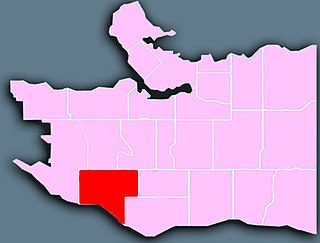
Kerrisdale is a neighbourhood in the city of Vancouver, British Columbia, Canada.
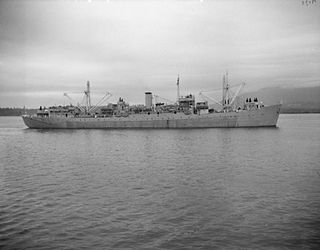
HMCS Cape Breton was a Royal Canadian Navy Cape-class maintenance ship. Originally built for the Royal Navy as HMS Flamborough Head in 1944, she was transferred in 1952. Upon her commissioning she was the second ship to bear the name Cape Breton. She served operationally from 1953–1964, when she was laid up. She was used as a floating machine shop until the late-1990s, before being sold for use as an artificial reef off the coast of British Columbia.
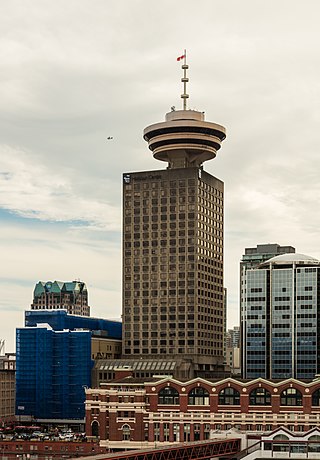
Harbour Centre is a skyscraper in the central business district of Downtown Vancouver, British Columbia, Canada which opened in 1977. The "Lookout" tower atop the office building makes it one of the tallest structures in Vancouver and a prominent landmark on the city's skyline. With its 360-degree viewing deck, it also serves as a tourist attraction with the Top of Vancouver Revolving Restaurant, offering a physically unobstructed view of the city.
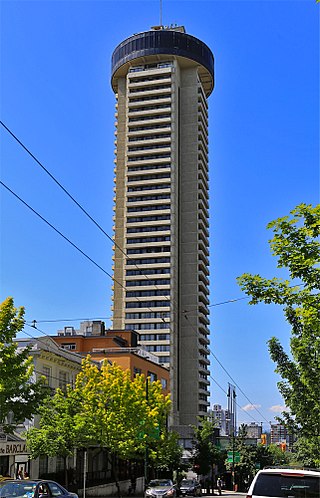
The Empire Landmark Hotel, often referred to by its original name, the Sheraton Landmark, was the tallest hotel in Vancouver, British Columbia. It was located on one of Vancouver's busiest thoroughfares at 1400 Robson Street, in the West End of Downtown Vancouver. The building was revolutionary (literally) at the time, as it had a revolving restaurant on its top floor, Cloud 9, which was one of only two revolving restaurants in Vancouver, the other being the Harbour Centre. Between its completion in 1973 and the completion of nearby Bentall Centre in 1974, the Empire Landmark Hotel was the third tallest building in Vancouver.
Sylvia Hotel may refer to:
Gambier Island is an island located in Howe Sound near Vancouver, British Columbia. It is about 17,049 acres in size and is located about 10 kilometres north of the Horseshoe Bay community and ferry terminal in westernmost West Vancouver.

The North Star hotel is a former hotel at the southern edge of Gastown in Vancouver, British Columbia, Canada. Located at 5 West Hastings Street, it is a four-story red brick Victorian Italianate construction completed at an unidentified date, between the 1890s and 1904.

James Bay is a high density neighbourhood of Victoria, British Columbia, Canada. It is the oldest residential neighbourhood on the west coast of North America that is north of San Francisco. It occupies the south side of the Inner Harbour close to downtown. Access to the neighbourhood is along Belleville Street, Government Street, Douglas Street and Dallas Road.

Victoria Harbour is a harbour, seaport, and seaplane airport in the Canadian city of Victoria, British Columbia. It serves as a cruise ship and ferry destination for tourists and visitors to the city and Vancouver Island. It is both a port of entry and an airport of entry for general aviation. Historically it was a shipbuilding and commercial fishing centre. While the Inner Harbour is fully within the City of Victoria, separating the city's downtown on its east side from the Victoria West neighbourhood, the Upper Harbour serves as the boundary between the City of Victoria and the district municipality of Esquimalt. The inner reaches are also bordered by the district of Saanich and the town of View Royal. Victoria is a federal "public harbour" as defined by Transport Canada. Several port facilities in the harbour are overseen and developed by the Greater Victoria Harbour Authority, however the harbour master's position is with Transport Canada.
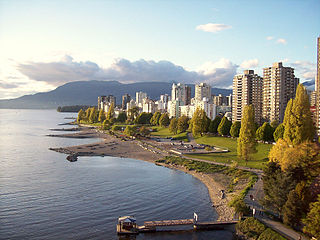
English Bay is a neighbourhood in the West End of Vancouver, British Columbia, Canada. Though not formally defined, it is a commonly used local appellation that refers to the shopping and residential areas focused on the intersection of Denman and Davie Streets near at English Bay Beach. Generally, the term refers to the first few blocks of residential areas flanking the beach from Stanley Park to Sunset Beach, and to the commercial areas along Davie Street, and along Denman Street south of Nelson Street.

The University Endowment Lands (UEL) is an unincorporated area that lies to the west of the city of Vancouver, British Columbia, Canada, and adjacent to the University of British Columbia (UBC) and the lands associated with that campus. Pacific Spirit Regional Park lies within the UEL. The UEL is part of Metro Vancouver. Mail sent to the UEL is addressed to "Vancouver" rather than the UEL.

The Law Courts building is part of the landmark Robson Square complex in downtown Vancouver, British Columbia, Canada. It was designed by renowned Canadian architect Arthur Erickson. The Law Courts building occupies the southern block of the three city block complex, provincial government offices the middle block, and the Vancouver Art Gallery the northern block. The building is used exclusively by the two higher courts of the Province of British Columbia: the Supreme Court and the Court of Appeal.

140 West 57th Street, also known as The Beaufort, is an office building on 57th Street between Sixth Avenue and Seventh Avenue in Midtown Manhattan in New York City. It was built from 1907 to 1909 and designed by Pollard and Steinam, who also simultaneously designed the neighboring, nearly identical building at 130 West 57th Street. The buildings are among several in Manhattan that were built in the early 20th century as both studio and residences for artists.

First Narrows is the official name for the entrance to Burrard Inlet, the mouth of Vancouver, British Columbia's inner harbour.

















